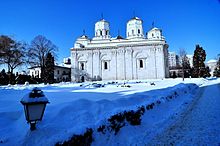Golia Monastery
| Golia Monastery | |
|---|---|
 The church of the Golia Monastery | |
| Religion | |
| Affiliation | Eastern Orthodox |
| Location | |
| Location | Cuza Vodă Street 51, Iași, Romania |
| Architecture | |
| Architect(s) | Vasile and Ștefăniță Lupu |
| Style | Baroque, Byzantine, Renaissance |
| Groundbreaking | 1650 |
| Completed | 1660 |
| Specifications | |
| Spire height | 30 m |
| Materials | Stone, brick |
| Website | |
| www | |
The Golia Monastery (Romanian: Mănăstirea Golia) is a Romanian Orthodox monastery located in Iaşi, Romania. The monastery is listed in the National Register of Historic Monuments.[1] In 2012, the conservation of the Monastery was awarded the European Union Prize for Cultural Heritage / Europa Nostra Award.[2][3]
History

Located in the middle of the old Moldavian capital and raised on the foundation of the church eracted, in the 16th century, by the boyar Ioan Golia, the monastery was rebuilt on a greater scale by Prince Vasile Lupu, between 1650 and 1653, and completed by his son Ştefăniţă.
The monastery is surrounded by tall walls, with corner turrets and a 30 m (98.43 ft) height tower with 120 steps, one of city’s symbols, and houses the Ion Creangă Museum (the writer was curate of the church) and Doxologia Cultural Missionary Centre of the Metropolis of Moldavia and Bukovina.[4][5]
References
External links
- Churches and monasteries in Iaşi at Iași City Hall website
